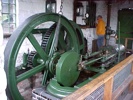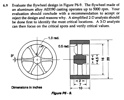 I’ve been re-reading Jim Collins’ “Good to Great: Why Some Companies Make the Leap… and Others Don’t” (Jim Collins) this week. His recent monograph on applying Good to Great principles to the social sector ought to be mandatory reading for all of us. I’ll probably pull out some other insights in future posts.
I’ve been re-reading Jim Collins’ “Good to Great: Why Some Companies Make the Leap… and Others Don’t” (Jim Collins) this week. His recent monograph on applying Good to Great principles to the social sector ought to be mandatory reading for all of us. I’ll probably pull out some other insights in future posts.
Anyway, his metaphor of a “flywheel” reminded me of what seems to be the physics behind movement building. So, here’s the metaphor explained. As you read it, think of the four marks of a movement as “pushes” of the flywheel. As we “connect with the seeking, help build transformed disciples, multiply leaders and generate resources (volunteers, materials, funding), we push on the flywheel. The hard work of sustained pushing eventually results in breakthrough.

Picture a huge, heavy flywheel — a massive metal disk mounted horizontally on an axle, about 30 feet in diameter, 2 feet thick, and weighing about 5,000 pounds. Now imagine that your task is to get the flywheel rotating on the axle as fast and long as possible.
Pushing with great effort, you get the flywheel to inch forward, moving almost imperceptibly at first. You keep pushing and, after two or three hours of persistent effort, you get the flywheel to complete one entire turn.
You keep pushing, and the flywheel begins to move a bit faster, and with continued effort, you move it around a second rotation. You keep pushing in a consistent direction.
Three turns…four…five…six…nine…ten…it builds momentum…eleven…twelve…moving faster with each turn…twenty…thirty…fifty…a hundred.
Then, at some point !breakthrough! The momentum of the thing kicks in your favor, hurling the flywheel forward, turn after turn…whoosh!…its own heavy weight working for you. You’re pushing no harder than during the first rotation, but the flywheel goes faster and faster. Each turn of the flywheel builds upon work done earlier, compounding your investment of effort. A thousand times faster, then ten thousand, then a hundred thousand. The huge heavy disk flies forward, with almost unstoppable momentum.
Now suppose someone came along and asked: ‘What was the one big push that caused this thing to go so fast?’
You wouldn’t be able to answer; it’s just a non-sensical question. Was it the first push? The second? The fifth? The hundredth? No! It was all of them added together in an overall accumulation of effort applied in a consistent direction. Some pushes may have been bigger than others, but any single heave ”no matter how large”reflects a small fraction of the entire cumulative effect upon the flywheel….
No matter how dramatic the end result, the…transformation never happened in one fell swoop. There was no single defining action, no grand program, no one killer innovation, no solitary lucky break, no wrenching revolution.
Good to great comes by a cumulative process ”step by step, action by action, decision by decision, turn by turn of the flywheel” that adds up to a sustained and spectacular result.
Leave a Reply